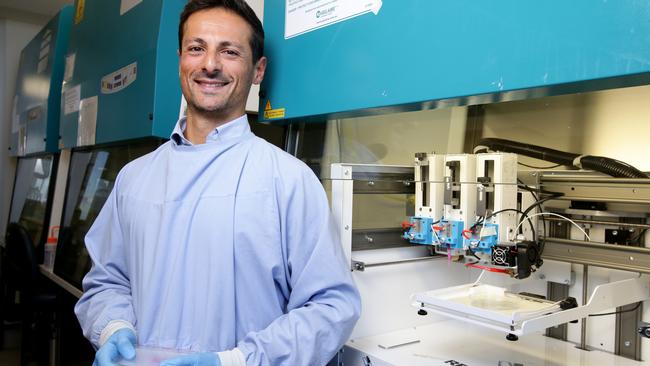Dr Carmine Gentile leads world-first research to create mini-hearts to grow patches to fix defects
Five-year-old Azariah Harb has already endured three open-heart surgeries, but a new invention could see surgeons build her a “mini heart” to give her the best chance at a normal life.
NSW
Don't miss out on the headlines from NSW. Followed categories will be added to My News.
Azariah Harb has already endured three open-heart surgeries but a new invention could see surgeons build the five-year-old her very own “mini heart” to give her the best chance at a normal life.
The best chance to jump as high as her older sister Veronica on the trampoline; to keep up with her friends in a game of tag in the playground; and the only real opportunity to imagine a future without constant hospital admissions and surgery.
The invention from a team of scientists from Sydney’s Heart Research Institute (HRI) may also be her best bet at avoiding an agonising wait on an already heaving transplant list for a replacement heart that may never come.
“Azariah was born with four defects in her heart and had her first major surgery at just six days old,” her mother Joanne, from Sydney, said.
“At four months old she underwent her second open-heart surgery and at four years she was in surgery for 24 hours for a major restructure of her heart.


“After that she had to learn to talk, walk and eat again and she requires constant monitoring and we’re looking at future surgeries.
“If all else fails our only option is a heart transplant. This new invention gives parents like us hope that there might be another option if our child faces heart failure — that there’s something else we can try.”

Thousands of Australians living with congenital heart disease — and thousands more suffering from heart failure due to cardiovascular disease — could benefit from the world-first alternative to heart transplants.
HRI scientists have created “mini-hearts” in the laboratory using a patient’s own cells and a specialised 3D bio-printer that pumps out 3D bio-printed heart tissues to their exact measurements.
The mini hearts have been created to form a patch to replace or repair damaged areas of the heart. They’ve been designed to be folded, so instead of open-heart surgery, they can be inserted via less invasive keyhole surgery.
Lead researcher Dr Carmine Gentile said: “Over 10,000 Australians develop heart failure every year, and only 120 on average receive a heart transplant – there’s a huge gap we’re trying to fill.

“So my team — in partnership with the University of Technology, Sydney — has been working on an alternative approach where from a blood donation from a patient we can create stem cells, which in turn become blood vessel and muscle cells to create the mini hearts.
“We then build them up to create the shape of the patch needed to repair the damaged heart — in much the same way as people use LEGO bricks to create a particular shape or object.
“The plan is to then transplant them in a safe way into the patient, where they will work to help regain the beating activity typical of a healthy heart.”
Successful in pre-clinical trials, the team now hopes to take the research from the “bench to the bedside” by forging ahead with clinical trials — with help from donations by organisations and individuals.
For parents like Joanne and Paul Harb, it’s a much-needed investment.
“We want to one day get to a place where we’re not always stopping Azariah, telling her to not jump too high, nor run too fast,” Mrs Harb said.
“She’s a fighter, she wouldn’t be able to get through what she has otherwise, but we don’t want her whole life to be a battle.”
Got a news tip? Email weekendtele@news.com.au



